April 27, 2015 at 5:52 am (botany, ecology)
Tags: bloodroot, Carex pensylvanica, common blue violet, common oak sedge, cutleaf toothwort, Dentaria laciniata, Dicentra cucullaria, Dutchman's breeches, Erythronium albidum, Mayslake, phenology, Sanguinaria canadensis, Viola papilionacea, white trout lily
by Carl Strang
After the spring beauties broke winter’s long suppression of wildflowers, other plants quickly have begun to bloom at Mayslake Forest Preserve.

Bloodroot is a popular subject for nature photographers. Seed-carrying ants have been spreading this species in several directions from one initial colony in the south savanna.
Bloodroot is one of many plants in several families which convergently have evolved little edible handles called elaiosomes on their seeds. The ants carry the seeds to their nests, and after consuming the elaiosomes discard (plant) the seeds.

Dutchman’s breeches likewise are spreading impressively from their starting point.

The year’s earliest sedge to bloom on the preserve, the common oak sedge, also is flowering, here surrounded by white trout lilies and cutleaf toothworts.
The trout lilies and toothworts are flowering now, along with common blue violets and others. So far these few species are pointing to an average to slightly early year as measured by flower phenology at Mayslake.
Leave a Comment
May 3, 2013 at 5:41 am (botany, ecology)
Tags: bloodroot, common blue violet, cutleaf toothwort, Dentaria laciniata, Erythronium albidum, Mayslake, phenology, Sanguinaria canadensis, Viola sororia, white trout lily
by Carl Strang
We finally got some flowers in April, so it is possible to quantify how late this spring has been compared to recent years. It should be no surprise that this is the latest spring of the last 5, at least as measured by first flower dates at Mayslake Forest Preserve. It also should be no surprise that the biggest contrast is between this year and last. For the 13 species of plants I could compare, the median difference was more than a month, with 2013’s median 34 days later than that for 2012.

Bloodroot hit the median exactly, blooming 34 days later this year than last.
The smallest difference was between 2013 and 2011 (the year of the Snowmageddon blizzard). Twelve species bloomed a median 4.5 days later this year.

Common blue violets flowered 4 days later this year than in 2011.
Looking back at 2010, the difference is another big one, at 17 days (11 species).

Trout lilies hit the median, 17 days later in 2013 than in 2010.
Finally we go back to 2009, my first spring at Mayslake. It seems we have alternated early and late years, as the difference again is smaller. Nine species of plants bloomed a median 5 days later in 2013 than in 2009.

The representative example in this comparison is cutleaf toothwort, right on the 5-day median difference.
If 2013 runs true to form, there will be a gradual convergence of dates as the spring and summer progress.
Leave a Comment
April 24, 2013 at 5:41 am (botany, dragonflies and damselflies, ecology, plant-eating insects)
Tags: Anax junius, bloodroot, cabbage white, Claytonia virginica, common green darner, Erythronium albidum, Mayslake, mourning cloak, Nymphalis antiopa, Pieris rapae, Sanguinaria canadensis, seasons, spring beauty, white trout lily
by Carl Strang
By my own subjective criteria, I have to declare that spring finally arrived, with a whimper, on April 16. I wasn’t at Mayslake Forest Preserve that day to see it, but the next day was a cold one, and it was clear that a few trout lilies and spring beauties had bloomed but then closed up in the lowered temperature. The weather stayed cold then, and so it wasn’t until Monday of this week that spring was manifestly present. One of its heralds was a patch of white trout lilies.

A representative bloom.
Spring beauties were scattered in little patches across the savanna.

Pink guidelines point the way to the flower’s center.
A bonus was a colony of bloodroots.

They formed a circle reminiscent of a fairy ring.
That warm day also brought the first green darner dragonfly, and mourning cloak and cabbage white butterflies. We haven’t seen the last of the cool weather, but winter appears to be done.
Leave a Comment
April 28, 2011 at 6:18 am (botany, ecology, gardening, insects (other))
Tags: bloodroot, elaiosome, Sanguinaria canadensis, seed dispersal, Solidago flexicaulis, zig-zag goldenrod
by Carl Strang
I have planted 3 bloodroots in my shaded garden flowerbed. They are the earliest of my native plants to flower each year, and all have multiplied by root expansion. This year they demonstrated their fecundity in a different way. A fourth plant, growing several feet beyond the nearest established bloodroot, has matured enough to flower.

- I had noticed leaves here the past year or two.
I would not have planted a bloodroot up against the edging like this, but it’s not an unreasonable place for an ant colony to do so. Ants are the main dispersers of bloodroot seeds, as well as those of a number of other plant species that bloom in our forests in early spring. Their seeds tempt the ants with fatty outgrowths called elaiosomes. Using these as handles, ants carry them to their nests. After consuming the elaiosomes the ants discard the useless (to them) seeds, having conveniently (for the plant) carried them into the protective soil.
This is very satisfying. Mine is not a hands-off garden. I have to work diligently, for example, to constrain the zig-zag goldenrods. But in this case I welcome the ants’ partnership, and look forward to watching the expansion of this newest bloodroot colony.
4 Comments
April 25, 2011 at 6:05 am (botany, insects (other), restoration)
Tags: bee fly, bloodroot, Bombus impatiens, Bombylius major, buckthorn, bumblebee, Claytonia virginica, Dicentra cucullaria, Dutchman's breeches, Erythronium albidum, Mayslake, phenology, Rhamnus cathartica, Sanguinaria canadensis, spring beauty, white trout lily
by Carl Strang
Spring advances, despite the unpleasant weather that has denied our enjoyment of much of it so far. As I have sloshed through the rain and the mud at Mayslake Forest Preserve, I have been finding the first of the woodland wildflowers, so I guess it hasn’t really been as cold as I have thought.
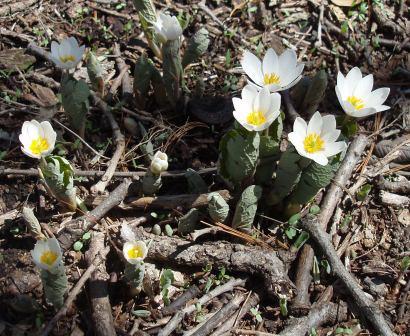
- Bloodroots have been blooming for what seems an extended period, though. Perhaps the temperatures have been marginal for them.
Lots of spring beauties have taken advantage of last fall’s burn in the south savanna.
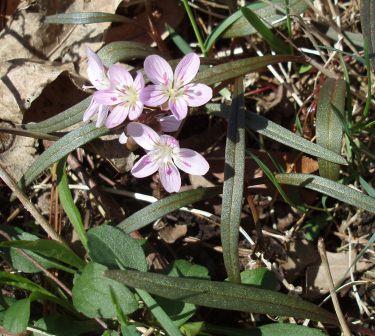
- These haven’t hit their peak, yet.
Views of pollinators still have been few.
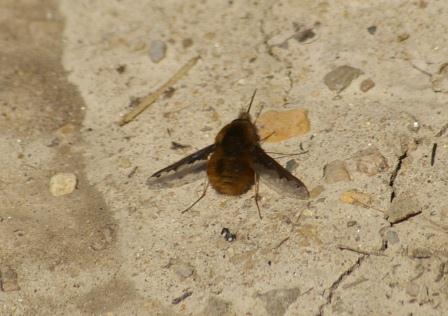
- In addition to this bee fly, I have seen the first of the year’s queen Bombus impatiens bumblebees.
The expansion of the Dutchman’s breeches population is gratifying.
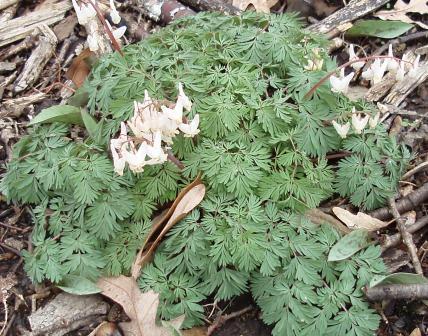
- These make me smile whenever I see them.
Ongoing restoration clearing of buckthorn has shown the quickest response by trout lilies, which now can be found in great numbers in many places on the preserve.
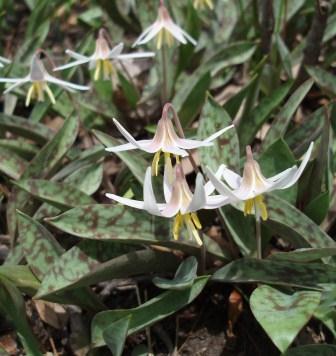
- Their flowers haven’t been open on many days, yet, needing temperatures above 50F or so.
It’s a little early yet to do a serious phenological comparison, but so far, compared to the last two years at Mayslake, first flower dates in 2011 have been the earliest for one species, latest for 2 species, and between those of 2009 and 2010 for 5 species.
Leave a Comment
April 13, 2010 at 9:41 pm (botany)
Tags: Barbarea vulgaris, bloodroot, Claytonia virginica, common blue violet, Erythronium albidum, Mayslake, phenology, Sanguinaria canadensis, Scilla sibirica, Siberian squill, spring beauty, Viola sororia, white trout lily, winter cress
by Carl Strang
The spring of 2009 was remarkable for its rain and low temperatures. This year has been much warmer so far, and the early first flowering dates at Mayslake Forest Preserve have been reflecting that difference. Spring beauties were the first forbs to bloom this year, 18 days ahead of last year.

Soon they were followed by last year’s earliest, common blue violets, which began flowering 9 days before the first one last year.

White trout lilies showed their usual amazing rapid appearance, their colorful mottled leaves followed closely by their initial blooms. Their first flowers appeared 11 days earlier than in 2009.

I have found only one little colony of bloodroot on the preserve. It did not flower last year, but this year was different.

The most recent new flowers were on this winter cress.

These were 14 days ahead of the first flowering date for that species last year. Mayslake also has a legacy of introduced domestic or garden plants, and these, too, are responding to the rapid increase in soil temperature. I found Siberian squills flowering 27 days ahead of last year’s first date.

I will continue to follow the phenology of flowering at Mayslake. The typical pattern is for early species to reflect the weather of the current year, but as summer progresses the differences between years tend to diminish.
1 Comment
April 7, 2010 at 9:41 pm (botany, ecology, gardening, insects (other))
Tags: Apidae, bloodroot, Eucerini, pollination, Sanguinaria canadensis
by Carl Strang
While I enjoy seeing the daffodils and Siberian squills blooming in my yard in early spring, what I most anticipate are the first native wildflowers, the bloodroots.

This year as I checked out the first two bloodroot clusters in bloom, I noticed a dark spot in one of the flowers.

This proved to be not just one bee, but two, apparently mating. As this choice of perch makes them stand out visually, I assume it was not a random choice, but a sign that these bees include bloodroot as a food source and therefore are potential pollinators. As I have a growing interest in native pollinator-flower partners, I looked into what is known for bloodroot. Literature available on the Internet indicates that native bees of several families are known to visit bloodroot flowers. Members of the Adrenidae may be the most important bee family for that plant, but other pollinators belong to the bee families Apidae and Halictidae, with other Hymenoptera as well as Hemiptera and Coleoptera mentioned.

Though the flowers were dancing in the wind that day, one of my photos was sharp enough to show some detail. My references on native bees are limited. As best I can tell, given what is visible of coloration, furriness, wing venation and especially antenna length on both individuals, these are “long-horned bees,” members of tribe Eucerini, family Apidae. In other words they are native relatives of the honeybee. They nest in tunnels which they dig in the soil, and are solitary rather than social colony-formers.
2 Comments
May 13, 2009 at 11:17 am (botany)
Tags: Aesculus glabra, Anemone quinquefolia, bloodroot, Capsella bursa-pastoris, choke cherry, common chickweed, Fragaria virginiana, golden Alexanders, Lonicera tatarica, Mayslake, Ohio buckeye, phenology, Prunus virginiana, purslane speedwell, Ranunculus abortivus, Ranunculus septentrionalis, red trillium, Sanguinaria canadensis, shepherd's purse, small-flowered buttercup, Stellaria media, swamp buttercup, tartarian honeysuckle, Trillium recurvatum, Veronica peregrina, Viola pubescens, wild strawberry, wood anemone, yellow violet, Zizia aurea
by Carl Strang
At the beginning of May the appearance of new wildflowers on Mayslake Forest Preserve accelerated. In some cases I have not made identifications, yet. For instance, there are a lot of small trees and shrubs in the rose family that probably are various crab apples and hawthorns, but may include introduced (and possibly horticultural) varieties that make identification difficult for a vertebrate ecologist. Among them are this one

and this one.

Here is an herbaceous plant flowering in the savanna that I can’t get a handle on, yet.

Its leaves are dense along the stem and embrace it like those of New England aster, but without the hairiness.

I suspect it may be in the mustard famiy, and if so should be able to get an identity as fruits appear.
Most new flowers I have been able to identify, though. Abundant swamp buttercups are flowering in the cleared area below the friary.

They, along with scattered small-flowered buttercups,

have joined the early buttercups already flowering there and elsewhere in the savanna. Also on that hill are red trilliums,

yellow violets (there’s a contradiction in terms for you!),

and wood anemones.

Not flowering on that hill this year, but another good find, was bloodroot.

Elsewhere on the preserve, appearances were made by the flowers of Ohio buckeye,

choke cherry,

wild strawberry,

purslane speedwell,

and golden Alexanders.

Non-native species include tartarian honeysuckle,

shepherd’s purse,

and common chickweed.

Again, all I am doing for now is establishing local first flowering dates in what will be an ongoing phenology study. No doubt I will return to some of these species for other future inquiries. For instance, what were all those ants doing on the golden Alexanders flowers?
2 Comments
April 8, 2009 at 10:45 am (birds, botany, ecology, gardening)
Tags: bloodroot, daffodil, Mayslake, Narcissus pseudonarcissus, robin, Sanguinaria canadensis, seasons
by Carl Strang
Yesterday I shared some of the first flowers in my yard, including a cluster of daffodils. Here are those daffodils after Sunday night’s snowstorm.

Here is the place where the bloodroots are blooming.

At Mayslake Forest Preserve on Monday morning I found that animal activity in the night had been minimal. Birds were foraging, however. Here is a string of robin tracks.

Robins have made the transition. No longer hopping from branch to branch to glean fruit, they are running over the ground in search of worms and other invertebrates, snow or no snow.
I was reminded that in my personal scheme there are six seasons in northeastern Illinois: spring, summer, fall, early winter, mid winter and late winter. Early winter is November and December, mid winter January and February, and late winter March to the middle of April. This April 5 snowfall is an example of why I don’t consider winter to be fully over, yet.
When I got home in the afternoon I found the daffodils bent but unwilted.

The bloodroots weren’t even bent.

Seasons, whether 4 or 6 in number, are a human framework. Early spring flowers make no assumptions, but stand ready for the wild variations that can come in their season.
3 Comments
April 7, 2009 at 10:58 am (botany, gardening)
Tags: Acer saccarinum, bloodroot, daffodil, Fraxinus pennsylvanica, green ash, landscape design, lawn, Narcissus pseudonarcissus, Sanguinaria canadensis, Scilla sibirica, Siberian squill, silver maple
by Carl Strang
On April 3 I noticed that the first bloodroot flowers were blooming in my garden.

This particular bunch is the one growing closest to the south face of my house, and so its soil warms relatively quickly. Others will bloom later. These were the first flowers of the year in my yard from a native species. They were not, however, the first flowers.

That honor always goes to Siberian squills, whose bulbs I planted in several patches a number of years ago. The bloodroot flowers were in a tie with the first daffodils, planted in honor of two friends who passed away in the late 1990’s.

Clearly I am not a purist when it comes to native species. To be sure, my gardens are heavily biased toward native plants (did you spot the redbud stem behind the daffodils?). I will share the different plantings in future posts, but today I want to focus on one point of landscape design. This is not my own idea, but one I learned from the Morton Arboretum’s former lead landscape architect, Tony Tyznik. He emphasized that it’s important to take a wide view, and consider one’s yard in the context of the surrounding neighborhood. My neighborhood is dominated by small yards, each typically a lawn with a green ash tree, some foundation shrubs, and a few flowers which almost entirely are of popular, non-native varieties.
My own yard is bigger than average because it is on a corner, and it has more trees than the others, 3 silver maples in addition to the ash. The extra trees allow me to minimize my lawn through the expansion of flowerbeds beneath the trees’ canopies. However, a thin strip of lawn remains to flow with those on either side (another Tyznik principle is to regard the lawn as the frame, not as the picture; a picture without a frame would be as unaesthetic as the typical suburban emphasis on the frame). Also, especially around the edges, I have scattered non-native annuals and perennials that reflect the popular choices of my neighbors. Behind those eye-catchers, there is a much larger area nearly pure in native plants. Despite the relatively low quality of my narrow lawn, I get frequent compliments from the neighbors: the small compromise of a few non-native flowers produces harmony in more than just the visual.
1 Comment

















































